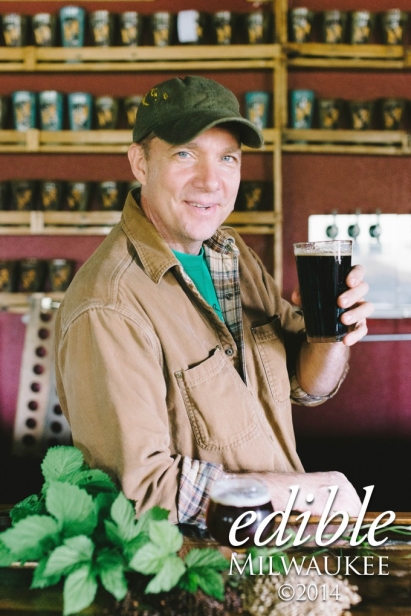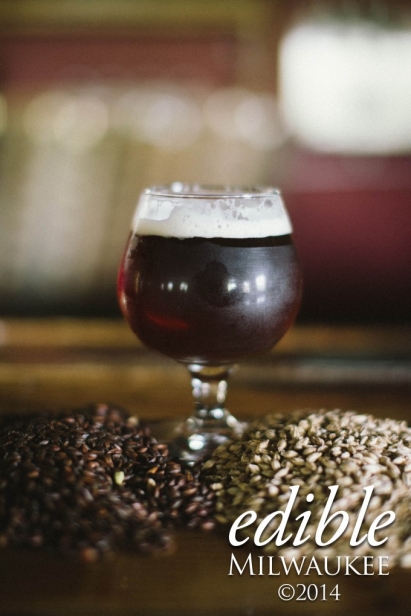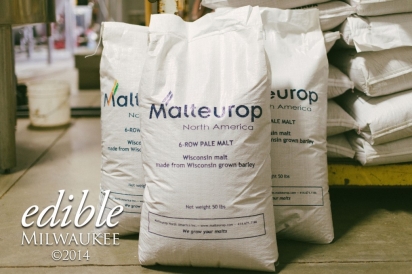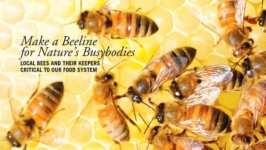Growing Grain Gold for Beer
Local brewers reviving Wisconsin hops, barley traditions
Long before Wisconsin became America’s Dairyland, Wisconsin brewed beer. The state had barley, wheat, ice, and water. It had hops. And most important of all, a beer-thirsty people called Wisconsin home.
So thirsty that in 1839, German settlers in Milwaukee, desperate for a taste of home, mixed whiskey and vinegar with a little limestone to create a head that they called “Essig whiskey heimer” (something like homemade vinegar whiskey or vinegar whiskey of home). The opening of the city’s first brewery – by a Welshman, not a German, alas – the next year hopefully put an end to that frightening blend.
Wisconsin is today virtually synonymous with the consumption of beer. The state’s abundance of raw materials (not to mention an abundance of marketing) made the state and especially Milwaukee famous for beer. Yet this once hyper-local product – nearly every Wisconsin town had a brewery at one time, and barley and hops were major state industries – became anything but, as commercial grain and hop production shifted west in the early 20th century. While the breweries remained, the ingredients scattered.
But that’s changing now. Interest in local ingredients for local craft beer is driving a resurgence in the cultivation of hops and barley for brewing in Wisconsin.
“People want to drink local beers,” says Rich Joseph, vice president of the Wisconsin Hop Exchange. “We just need more of them to start asking for local ingredients in that beer and be willing to pay a few cents more so we can bring it back to Wisconsin.”
Joseph is doing his part. An avid homebrewer, he decided to try growing hops on a two-acre plot of land owned by his father-in-law in Oconomowoc in 2009. But Joseph and his wife wanted land of their own, so in 2013 they purchased a farm south of Belleville to expand hop production. Joseph now has more than 5,000 hop plants in the ground at his farm, The Hop Garden. He’s even started brewing in collaboration with Madison’s House of Brews.
Hops serve as both a flavoring agent and preservative in beer. But while we may think of hops as an essential brewing ingredient, hops are a relatively new addition to the brewmaster’s toolkit. Pliny the Elder was the first to mention hops in his Naturalis Historia, first published between 77 and 79 CE. Even then, Pliny was only interested in the botanical history of this wild plant rather than its alcoholic promise. Ancient Romans ate young hop shoots in the spring like we enjoy asparagus. Hops also found widespread medicinal use as a treatment for anxiety and insomnia; people often slept on hop-filled pillows to combat sleeplessness.
Hops don’t appear in the record in relation to beer until 822 CE when French Benedictine Abbot Adalhard of Corbie included specific instructions for the use of wild hops for brewing in his abbey rulebook. Still, hopped beers took several more centuries to become common. Hops gained popularity in brewing for the balance they bring to beer. The plant contains acids and oils with bitter flavors that contrast with the sweetness of the malt. Brewers can adjust the ratio of sweet maltiness to bitterness as they brew by using different types of hops and modifying when they are added and how long they are boiled. Hops also add floral, herbal, and citrusy aromas. But flavor was only one reason hops became more widely used.
Many of the same elements that give hops their distinctive flavor also act as a preservative, allowing beer to stay fresh longer and travel farther. Legend has it that hops gave birth to the India Pale Ale in the 18th century as British brewers added hops to their barrels of strong ale to preserve it over the months-long sea voyage to India. While the truth of the story is debateable, the preservative effects of hops are not. Unhopped ales arrived from long voyages stale and skunked, but hopped beers tasted fresh and refreshingly bitter.
Growing hops is labor intensive. Everything must be done by hand. Hops start out as rhizomes about the size of a finger and take two to three years to reach maturity. Often referred to as a vine, hops are actually a bine that uses a strong stem and stiff hairs rather than tendrils and suckers to attach and climb upward. Growers must train the hops to climb the supports. During the peak growing season, hop plants can grow twenty inches per week, towering 20 feet in the air on poles and wires by harvest time in mid-August to mid-September. When ready, the hops must be harvested right away so many hands are needed. There are no mechanized hop harvesters. Its flower of the female plant ends up in the brew kettle, and being flowers, hops are delicate and require care. The plants then die back to the cold hardy rhizome in the fall.
“Hops take care of themselves once they are established but it’s still a lot of hard work from spring to fall, which can turn off a lot of beginning growers,” explains Joseph.
The growth of the beer industry in Milwaukee was directly related to the city’s large German immigrant population. German consumers demanded lager, a German-style barley and hop brew fermented and aged at low temperatures, which greatly expanded the city’s beer industry and provided for a large and thirsty customer base. Many of these German immigrants were experienced brewers, too, saving owners both time and money in getting started. The expansion of breweries, not just in Milwaukee but all over Wisconsin fueled a boom in beer’s raw materials and supported the growth of subsidiary industries like coopering, ice harvesting, saloon furnishings, and brewing equipment. By the 1890s, malting and brewing were Wisconsin’s third largest industries.
Commercially-produced hops were first introduced into Waukesha County around 1837. James Weaver brought hops with him from New York to Sussex. The first brewery didn’t open in Milwaukee until 1840 so Weaver likely made hopped beer at home. By 1860, Weaver had started a hop growing business with his sons in Lisbon known as Weaver and Bros., Brokers in Fancy Hops. Demand for hops made the family rich.
Weaver’s timing was right. Blight devastated the crop in New York and created a kind of gold rush for hop farming in Wisconsin. As hop prices spiked in the 1860s, westward-moving settlers and Civil War veterans converged on the state looking for opportunities. A hop craze ensued. Hops need to be dried for brewing, so two-story hop drying towers popped up all over southern Wisconsin. The Weavers owned five of the six hop drying towers in Lisbon. The boom was centered in Sauk County, where, at the height of the hop craze, in 1867, the county’s six thousand acres produced nearly half of the state’s more than 6 million pounds of hops.
At harvest time, hop pickers were in great demand. Young women came from all parts of the state to pull cones from the bines while others abandoned their families for the excitement of the hop yard. Nighttime entertainment frequently included dancing, socials that came to be known as hops.
Boom quickly gave way to bust. Mildew and then aphids decimated the crop, just as they had in New York, while production out West caused prices to drop. Many farmers had plowed under their hop yards by 1870. By the early 20th century, Washington led the nation in commercial hops, a title the state still holds.
Ironically, it was blight that helped to resuscitate Wisconsin-grown hops. Skyrocketing hop prices after drought and storm damage in Europe and a major warehouse fire in Washington state brought a wave of interest in local hop production in 2008. The crisis gave birth to the Wisconsin Hop Exchange, a cooperative working to bring a commercial hop industry back to Wisconsin, as well as Gorst Valley Hops in Mazomanie.
“It’s so much easier to work with hops now,” says Grant Pauly, brewmaster at 3 Sheeps Brewing in Sheboygan, of these new hop organizations. “Because hops take time to establish, farmers make no money for a few years, so that makes it really hard for an industry to restart. Wisconsin needed companies like this to organize the raising and processing of hops locally.”
A hop yard has also taken root at the Fondy Farm in Milwaukee where the predominately Hmong growers are learning this new crop.
Fondy Food Center Executive Director Young Kim says the hop yard is part of a larger effort at diversification. “The more diverse crops we can grow, the better chance we have of growing a resilient farm,” says Kim. “We want to make farming sustainable from both an economic and environmental standpoint.”
While the Fondy Farm hops are still in the experimental stage at this point, Kim says they are exploring ways to distribute hops to homebrewers and nanobreweries.
Although the output remains small, Wisconsin hops are making their way into local beer. Brewer Mark Duchow of Sweet Mullets Brewing Co. in Oconomowoc uses as many local ingredients as he can get. He says that access to these products guides his brewing choices.
“We don’t have that much trouble finding local ingredients but I will brew to focus on a special ingredient,” says Duchow.
He’s even taken to growing some of his own hops on a farm in Green County and another in Clyman to supply his brewery.
Cost is one major obstacle. The Wisconsin Hop Exchange currently has between 30 and 40 acres of hops in production statewide. Joseph estimates that his co-op needs around 100 acres to be a sustainable and stable business for its members. At that size, the growers will gain some efficiencies that will lower the costs of production and make Wisconsin hops more competitive with western hops.
Hops are only one part of the local brewing equation. Sweetness and sugar come from malted grain. Many Wisconsin brewers rely on Briess Malt & Ingredients Co., which has been malting in Chilton since 1876. When Briess opened for business, Wisconsin was one of the nation’s largest producers of barley for brewing. The state’s barley and malting industry collapsed during Prohibition, however, and like hops, commercial production moved west.
Briess today sources most of its barley outside Wisconsin, but the company does malt wheat from Washington Island. Some Wisconsin-grown barley does end up in the malts of Malteurop, an international malting company with its North American headquarters in Milwaukee.
Barley is coming back to Wisconsin, though, driven by craft brewing. The short growing season in northern Wisconsin makes barley a potentially more profitable crop than corn, particularly as new varieties of barley are developed to compete with the high quality types grown in the West. The Peninsular Agricultural Research Station in Sturgeon Bay is growing test crops of barley while the Cereal Crops Research Unit in Madison is evaluating the quality of that grain for craft brewing.
“It’s exciting to be a new part of an old Wisconsin industry,” says 3 Sheeps’ Pauly. “That heritage actually makes it easier to source locally.”
Pauly himself is part of that heritage. His family purchased the bankrupt Gutsch Brewery in Manitowoc in 1926, renamed it Kingsbury Brewery, and expanded coast-to-coast. Although the brewery had long since been sold by the time Pauly was born, he grew up hearing stories about the family beer business.
“It definitely made the idea of owning my own brewery seem possible,” explains Pauly. “My family had done it before so I figured I could do it again.”
Pauly purchased his equipment from a closed brewpub in town and found nearly everything else he needed, from tap handles (Random Lake) to 6-pack carriers (Milwaukee), from Wisconsin companies. Like many state brewers, Pauly uses Briess malts and plans to release an all-Wisconsin hopped beer in the fall.
“We have an amazing brewing infrastructure that goes beyond the raw ingredients of beer that I’m not sure exists in other places,” says Pauly. “Wisconsin’s early start in brewing means the industry has had a long time to develop.”
Wisconsin is well positioned to bring brewing back home with its history, agricultural diversity, and growing craft beer industry. It won’t be easy. The size of the grain and hop industries in other parts of the country make price a prime concern, particularly for craft brewers running on tight margins.
But both brewers and growers seem optimistic, if only because they are having so much fun.
Joseph loves seeing the huge “green walls” that grow up around him every year in the hop yard. He enjoys leading workshops on backyard hop growing and encouraging people to think about drinking local just as much as they may eat local.
“Craft brewing is growing but it’s still a very small part of the beer market so we have plenty of room for growth,” says Pauly. “That’s exciting for me. I mean, on my worst day, I still get to make beer so that’s still a pretty good day.”
The Flavors of Hops
Hops are the darling of craft brewers. Selecting the perfect hop strain is an essential part of the brewing art. While some brewers use fresh whole hops, most brewers employ hops in a pelletized form because they are easier to use and have a much longer shelf life.
While there are dozens of varieties, hops fall into basically two types. Aroma hops have a lower acid percentage and a good aroma, and are generally used as a finishing hop. Bitter hops have a higher acid percentage and are generally used in the boiling process to extract bitterness. Some hops do a bit of both.
There is little research into the ideal hop varieties for Wisconsin. The most common commercial types come from the Pacific Northwest or Europe, but interest in local hops is driving efforts to develop Midwestern strains.
Hoppiness is usually identified as pungent, floral, citrusy, woody, herbaceous, peppery, earthy, or minty. Most beers combine several varieties. Here are some common hops you might meet in your glass:
Cascade – Very popular variety with moderate bitterness and a distinctive citrus and grapefruit flavor.
Local beer: Lakefront’s IPA (Cascade and Chinook), Milwaukee Brewing Company’s Pull Chain (Cascade and East Kent Goldings)
Centennial – Often called “super Cascade,” Centennial has a similar flavor but packs more bitterness.
Chinook – Primarily used for bitterness, Chinook has herbal and even smoky characteristics.
Local beer: Lakefront’s Fixed Gear (Chinook and Cascade)
Columbus – High oil content yields a potent aroma of earth and herbs that often takes a supporting role to more citrusy varieties like Cascade.
Mt. Hood – An aromatic variety with a refined, spicy aroma and clean bittering.
Local beer: Lakefront’s Klisch Pilsner and Eastside Dark
Nugget – Bitter with a heavy herbal aroma.
Perle – Clean flavor with an almost minty bitterness.
Local beer: Milwaukee Brewing Company’s Hoptoberfest (Perle, Columbus, and Tettnang)
Willamette – A popular aroma hop with mild, earthy flavors and a slight woodiness.
Behind the Numbers: IBUs or International Bitterness Units
As hoppy beers have exploded in popularity, brewers often boast of their high IBUs. But that number won’t tell you how hoppy a beer tastes.
Hoppiness is measured in IBUs (International Bitterness Units), which indicates the concentration of isomerized alpha acid—the compound that makes hops taste bitter—in a brew. It’s common to find IBUs listed on beer bottles and on the menus of craft beer bars. The scale starts at 0 and is theoretically open-ended but there are those that claim that our ability to detect bitterness maxes out at some point, though no one seems to agree on a number.
Essentially, the higher the number, the hoppier the beer but that can be misleading. Your perception of the bitterness might be different based on the other ingredients in the beer. Taste is subjective but IBUs, as a chemical measurement, are not.










